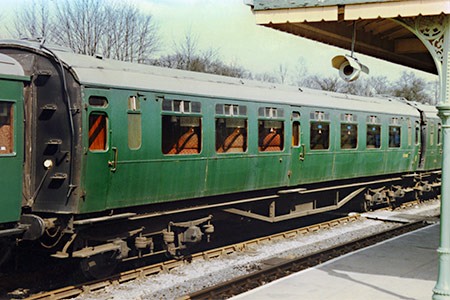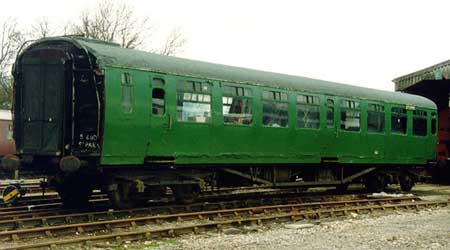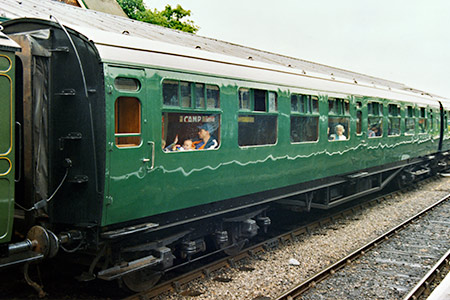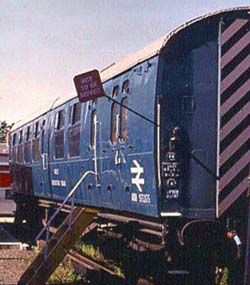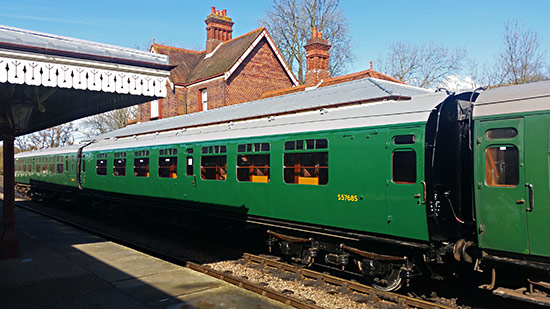

|


|

|
|
Carriage & Wagon Dept - Stock Lists: Carriages, Vans, Wagons & Multiple Units - C&W News SR Coach Group - Goods Division - Operation Undercover - Technical - Join us 

Carriage Fleet Review - 6The Bulleid Coaches at the CrossroadsPlease read this article, written in 1995, in conjunction with updates towards the bottom of the page.The sixth article in this series considers the Railway's Bulleid coaches, for so long the backbone of the operational fleet. Historically they represent the transition from the wooden structured Maunsell to the all-steel Mark I. Stylistically very much advanced for the immediate post-war era, there are few who would deny the superiority of the Bulleid saloon with its large picture windows over the succeeding Mark I design. Beneath the surface, the uneasy combination of wood and steel construction, primitive welding techniques and metal window frames pose their own problems for the would-be restorer.The surviving Bulleid carriages fall into three distinct categories, Southern Railway, contractor and British Railways builds. The Bluebell, uniquely, has examples of all three, so covering the historical range. Regrettably (from a historical point of view, although not from the point of view of the difficulty which its restoration would have posed) the only early, short, Bulleid coach to survive into preservation (on another line) was scrapped back in 1988.
5768 (a Corridor Composite) and 1456 (an Open Third) are the only Southern Railway built examples on the Bluebell. One of the last of its type in service in 1968, No.5768 was purchased by the Bulleid Society to complement Blackmore Vale, and entered traffic on the Bluebell in 1977. For many years it provided much needed first-class accommodation and an all too clear demonstration of the deficiencies of the original design - its career being punctuated by rust-induced cracking of the vulnerable large side-lights (windows). Withdrawn from traffic in 1994 it awaits a comprehensive structural rebuilding and resheeting. There is a separate web page for this carriage. No.1456 was one of the original Bournemouth-line coaches, and has the steel bodyside sheeting continued down to cover the solebars. It has been on the Bluebell since 1980, and has served as our varnishing workshop. Formerly in the ownership of the NRM, it has not had any restoration work carried out on it, since in the absence of any long-term agreement, it could be recalled to York at any time.
Following its transfer to Bluebell ownership in 1996, its future now looks happier, although with our other Bulleid Open Thirds ahead of it in the queue for attention, its restoration is no more than a long-term hope.
Nos.1464, 1481 and 1482: British Railways built these open thirds in 1950 to a modified design, the most obvious differences being deeper sliding windows and shallower main lights. Less noticeable are the solid 2 1/2 inch thick body timbers and an LMS (Wolverton) type electric lighting system. 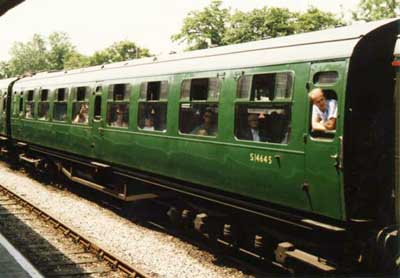 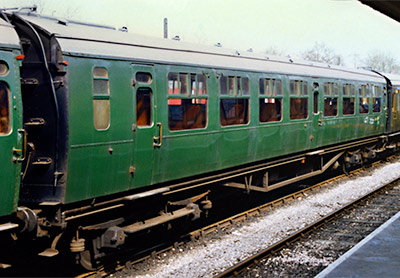
No.1464 and No.1481 Meanwhile No.1482 had been transferred to the Scottish Region where it had been withdrawn in 1969. Salvation came when still completely intact it was used as a "Bothey" in a Glasgow carriage shed until discovery led to preservation in 1973.
Nos.1481 and 1482 have been particularly hard worked. They have served Bluebell as long as the Southern Region, and after over 20 years in Bluebell Service, both needed a heavy overhaul. No.1482 was withdrawn from traffic in 1996 for replacement of the external steel sheeting and window frames, which was completed in June 2000, at which time No.1481 was withdrawn pending similar work. No.1464, which entered traffic in 1986 is in better condition having benefited during restoration from much hard-won experience, and after 20 years in service has, during 2005 and the spring of 2006 received repairs to the steel sheeting and window frames, to enable it to remain in front-line service for hopefully another 20 years.
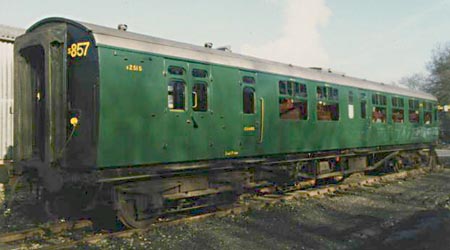 2515: No.2515 (photo: right) is the BR-built brake equivalent of the open thirds above, its 48 seats comparing very favourably with the 32 of an equivalent Mark I.
2515: No.2515 (photo: right) is the BR-built brake equivalent of the open thirds above, its 48 seats comparing very favourably with the 32 of an equivalent Mark I.
The coach owes its survival to an abortive scheme for conversion to a tunnel gauging van and a tenuous existence in Micheldever's condemned sidings before delivery to the Bluebell in 1973. Major restoration work in 1976 and 1977, and again a decade later, has ensured the continued availability of this stalwart of the traffic fleet.
Restoration of the identical 2526 started in June 2000. See postscript at the end of this article.
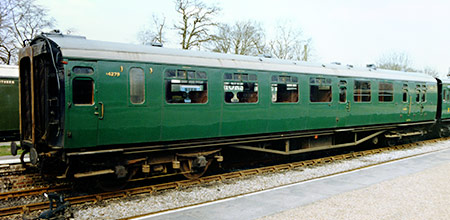 4279 was the railway's first Bulleid acquisition, and with No.4227, were built by the Birmingham Railway Carriage and Wagon Company to a hybrid design, combining a Bulleid style body with many features, most noticeably aluminium window frames, reminiscent of the last batch of Maunsell coaches. Constructed of poorer quality timber than their railway-built contemporaries, they are more susceptible to wet rot and leakage around the window frames. Both are brake thirds.
4279 was the railway's first Bulleid acquisition, and with No.4227, were built by the Birmingham Railway Carriage and Wagon Company to a hybrid design, combining a Bulleid style body with many features, most noticeably aluminium window frames, reminiscent of the last batch of Maunsell coaches. Constructed of poorer quality timber than their railway-built contemporaries, they are more susceptible to wet rot and leakage around the window frames. Both are brake thirds.
No.4279 arrived in 1970 after a spell as an office. Pressed into service with makeshift seating, it was not until 1979 that it emerged much rejuvenated after a two and a half year long overhaul. Eighteen years later it was again showing its age, and in 1997 had its roof recanvassed, and the windows rebedded. Some remedial work was also required to the body structure where water penetration has rotted the wooden framing.
No.4227 was acquired from the Bristol Harbour Railway in 1987 where it had been used as a store, following a period of departmental service with British Rail. The availability of seating and other fittings makes this 44-seat coach, with its coupé compartment and long brake a viable proposition for the future.
Conclusion: The condition of the Bulleid fleet all too clearly illustrates the problems and realities confronting the Carriage and Wagon Department. In 1990 it comprised six operational coaches, today there are five, in 2000 there could be just three. Resources are finite and the department could quite easily spend the lion's share of its "restoration time" between now and the millennium restoring and reinstating the status quo of 1990. Here lies the answer to Tony Usher (letter, Bluebell News Winter 1994), our Bulleid coaches are not only historically significant, but they are also essential to the operation of the railway in a way that LCDR No.48 can never be. Good quality coaches will be hard to come by in the future, and we neglect the Bulleids at our peril. It would be more than sad if the Bluebell News of 2005 contained letters lamenting their fate. Year 2000 Update:
After much soul searching, the Bulleid style steel window frames have been reproduced with box sections receiving extensive wax treatment to resist corrosion. One particularly unwelcome discovery was the extensive build-up of rust between the bottom plate on which the body is errected and the underframe, with both tack-welds and rivets being split apart. The remedy, involving complete gutting of the toilet ends and vestibules, was a major contribution to the protracted nature of the overhaul. The coach is not intended to be a museum piece, and has resumed front-line service in the same role as the ubiquitous Mark I TSO. Fixed tables introduced to meet the railway's operational and commercial requirements have been constructed along the same lines as the removable "Southern" version, with specially constructed brackets using the same screw-holes associated with the original loose table arrangement.
The future of the Bulleid fleet is looking healthier, although major work is still required on 1481 at some stage, but before that, restoration of 5768 is now in prospect. During the winter of 1997/8 both brakes, 4279 and 2515, received new roof canvases, and in 2000 a thorough overhaul was completed on 1482 (see above). Close examination of 2515 shows that this coach will require some major structural repairs to the body framing at floor and roof levels at some stage in the next decade.
Update March 2009:
Bulled brake 2526, which is from the same batch as No.2515 above, was acquired in 1999. Again this had been a departmental conversion, but surviving in good structural condition. Restoration of this vehicle commenced in June 2000, but was suspended temporarily in 2005 to enable the intermediate overhaul of 1464 to proceed. With work then resumed on 2526, and heading for completion in 2009, at which point 4279 will be withdrawn for an intermediate overhaul, with most work centred on the carriage ends, and intended to only take around a year. It is hoped that 2515 will last in service long enough to cover for the period when 4279 is out of service.
In addition to the above "preserved" coaches, the Bluebell is also host to the underframe of brake 4036, which was broken up for spare parts. A similar fate has befallen 4008 and 4035. These were coaches constructed with poor quality post-war timber, of slender cross-section, and had been heavily modified in departmental use, although some timbers in 4035 were discovered to be in remarkable general condition, and the bodyside sections have been retained against future need. Spare parts from these vehicles have been essential in the maintenance and restoration of our other Bulleids.
Update February 2023:
Right: Bulleid Composite 5768 at Sheffield Park - Martin Lawrence - 14 March 2019 Plans change, and with brakes 2515 withdrawn in the spring of 2010 (having been replaced in service by 2526) and 4279 limping on until January 2015, we have since run with just one Bulleid Brake, as Mk.1s have taken over as the main serice trains, and the Bulleids used more sparingly as a "vintage" set and for Galas and Santa Specials. With no prospect of an early overhaul on the Bluebell, in 2012 open third No.1456 was placed on a 25 year loan to the Mid Hants Railway. It was overhauled there with the help of a substantial National Lottery Heritage Fund grant, and returned to service there in early 2020 - Photos here. Following on from the restoration of 2526, completed in July 2009, Roger Williams' team took on the Corridor Composite 5768, which was completed in early 2019, as seen in the photo. His team also took on an intermediate overhaul of 1482, 20 years after its restoration, to ensure it was good for the next 20. This was undertaken in stages, alongside a re-trim, with the coach returning to service for major events, but this was left only 3/4 finished at the time of Roger's untimely death a year later. Although the carriage is currently serviceable, it is now hoped that, using money left by Roger for the purpose, this project can be completed in the near future, and then further Bulleid carriages overhauled as a fitting legacy to Roger's dedication. Open Third 1464, having been in service since 1986, is approaching time for another intermediate overhaul. On to the next article in the series.


Return to BRPS Home Page, to the Timetable or to Special Events Carriages & Wagons - Intro - Development - Stock Lists: Carriages, Vans, Wagons & Multiple Units - Carriage Fleet Review - Join us C&W Works News - SR Coach Group - Goods Division - Operation Undercover - Carriage Shop - Technical Pages Visitor Info. - Museum - Trust - Catering - Contacts - What's New - Projects - Locos - Carriages & Wagons - Signals - History - Other - Links - Search - FAQ Why not become a BRPS Member? - Get more involved as a Volunteer Last updated 25 March 2009 and 12 February 2023 by Richard Salmon. © Copyright BRPS. Privacy Policy |
